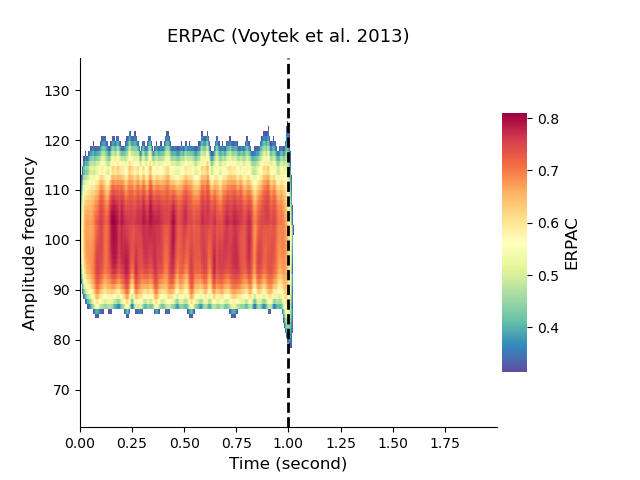Note
Click here to download the full example code
Event-Related Phase Amplitude Coupling¶
Event-Related Phase-Amplitude Coupling (ERPAC) do not measure PAC across time cycle but instead, across trials (just as proposed JP. Lachaux with the PLV/PLS). Measuring across trials enable to have a real-time estimation of PAC.
In this example, we generate a signal that have a 10hz phase <->100 hz amplitude coupling first followed by a random noise.
import numpy as np
from tensorpac import EventRelatedPac
from tensorpac.signals import pac_signals_wavelet
import matplotlib.pyplot as plt
Generate a synthetic signal¶
in order to illustrate how the ERPAC does works, we are going to concatenate two signals. A first one with an alpha <-> gamma coupling during one second and then a second one which is going to be a one second random noise
# First signal consisting of a one second 10 <-> 100hz coupling
n_epochs = 300
n_times = 1000
sf = 1000.
x1, tvec = pac_signals_wavelet(f_pha=10, f_amp=100, n_epochs=n_epochs,
noise=.8, n_times=n_times, sf=sf)
# Second signal : one second of random noise
x2 = np.random.rand(n_epochs, 1000)
# now, concatenate the two signals across the time axis
x = np.concatenate((x1, x2), axis=1)
time = np.arange(x.shape[1]) / sf
Define an ERPAC object and extract the phase and the amplitude¶
use
tensorpac.EventRelatedPac.filtermethod to extract phases and amplitudes
# define an ERPAC object
p = EventRelatedPac(f_pha=[9, 11], f_amp=(60, 140, 5, 1))
# method for correcting p-values for multiple comparisons
mcp = 'bonferroni'
# extract phases and amplitudes
erpac = p.filterfit(sf, x, method='circular', mcp=mcp).squeeze()
# get the p-values and squeeze unused dimensions
pvalues = p.pvalues.squeeze()
# set to nan everywhere it's not significant
erpac[pvalues > .05] = np.nan
vmin, vmax = np.nanmin(erpac), np.nanmax(erpac)
p.pacplot(erpac, time, p.yvec, xlabel='Time (second)',
cmap='Spectral_r', ylabel='Amplitude frequency', title=p.method,
cblabel='ERPAC', rmaxis=True, vmin=vmin, vmax=vmax)
plt.axvline(1., linestyle='--', color='k', linewidth=2)
p.show()

Total running time of the script: ( 0 minutes 7.979 seconds)
